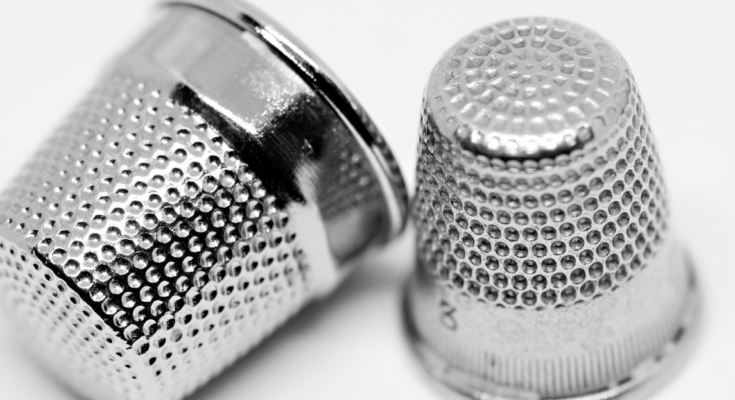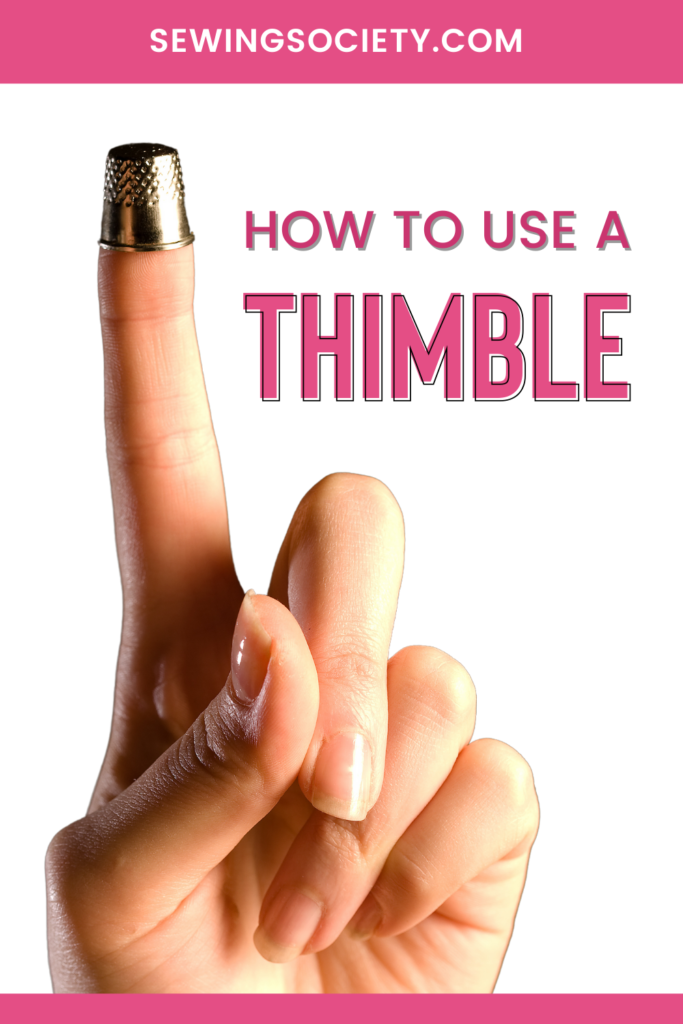Disclosure: This post may contain affiliate links. I earn a small commission when you click a link and make a purchase. Thanks for supporting SewingSociety.com!
An often-overlooked piece of sewing equipment is the thimble. While it’s not a necessity when sewing, once you’ve used one, you might fall in love! In this post, we want to answer your burning questions about thimbles, such as how to use one and which finger it goes on.
A ‘thimble’ is a small, usually metal cap that protects the finger you use to push down on sewing needles and other sharp objects. It’s a simple, yet clever device that has a long history, originating in Roman times. Its name (derived from Middle English) literally means ‘thumb shield’. Over time, thimbles have been made from various materials including leather, brass, bronze, iron, and silver, with some earlier versions being made from bone. Today, thimbles are often made from silicone or rubber, although you can still find the metal versions.
So, let’s get back to those questions about thimbles…
What Finger Does a Thimble Go On?
There is no one-right-way to wear a thimble! You can put it on any finger you need to protect.
Many people think a thimble should be worn on the index finger — this is the most common choice. However, there are three fingers a thimble is commonly worn over, depending on what you’re doing.
A thimble should be worn on your dominant hand, so if you’re right-handed, the thimble goes on your right hand and if you’re left-handed, it goes on your left hand. People sew in different ways, so the finger you choose will depend on whether you usually push your needle through your fabric with your index finger, thumb, or a different finger.
How Do You Use a Thimble?
By deciding carefully which finger to wear a thimble on, you’re already well on your way to avoiding clumsy sewing injuries caused by your hand not being properly positioned for the task at hand.
The next important step is to make sure your thimble fits. A well-fitting thimble stays snugly on your finger without being too tight. As a test, place a thimble on your chosen finger and lower your hand to your side. If it stays put and doesn’t feel too tight, you’ve found a good fit. There are special thimbles designed to fit thumbs, so if this is your preference, make sure you choose one of those.
As you start sewing, the thimble may feel strange or uncomfortable at first, but it shouldn’t take long to get used to. Using either the top or side of your finger (whichever feels most comfortable) use the finger with your thimble to push your needle through your fabric.
No more finger pricks has to be good!
Thimbles Are for More than Just Sewing…
Thimbles are a great solution for protecting your fingers when sewing, but they can also be used to protect your fingers when ironing and pressing fabric. There are thimbles specially designed for this purpose…
You can get some inexpensive Ironing Thimbles from Madam Sew. These heat-resistance finger covers are a real lifesaver, especially when you’re ironing small details and your fingers can’t help but be in the way.
Do you use a thimble when you sew or iron? Which finger do you like to wear it on? Let us know in the comments below.
Share this post on Pinterest!






2 Comments on “How to Use a Thimble”